|
Rebecca Novick, Groundwork USA
The Health Impacts Of Flooding
In addition to the physical damage to the built environment caused by flooding, more frequent and intense flooding also has a direct impact on our health. In urban areas with aging stormwater infrastructure, heavy rain can cause sewage overflows and waterborne diseases to spread. Standing water following storms can become hosts to mosquitos and other disease-carrying insects. Flooding in homes and basements can lead to mildew and mold, which worsens asthma, exacerbates other respiratory challenges, and causes illness. Extreme flood events can also lead to traumatic stress and amplify existing mental health challenges.
The impacts of flooding are of particular concern in the Midwest, where the amount of rainfall during intense precipitation events has increased by 42% since 1956. In Milwaukee, WI, the city government and the Milwaukee Metropolitan Sewerage District have begun efforts to renovate the old sewage system and install green infrastructure to help reduce the impact of flooding. It’s important that, as these improvements are made, priority is given to neighborhoods where residents will be most negatively impacted by flooding.
Data Drives Solutions
To help ensure that infrastructure is being prioritized where it’s needed most, Groundwork Milwaukee, in partnership with Wisconsin Health Professionals for Climate Action, The New School, Data You Can Use, and the Medical College of Wisconsin, carried out a Flood Health Vulnerability Assessment (FHVA) to identify neighborhoods in Milwaukee that are disproportionately at risk of flood damage. In this FHVA, Groundwork Milwaukee considered both flood exposure (the likelihood of an area flooding) and flood vulnerability (the degree to which residents will be impacted by flooding) at the Census tract level. They determined the flood vulnerability of each neighborhood by looking at a combination of health, socioeconomic and housing indicators, which taken together are indicative of a community’s capacity to survive, adapt and restore itself after a flood event.
 Flood exposure map of Milwaukee, WI.
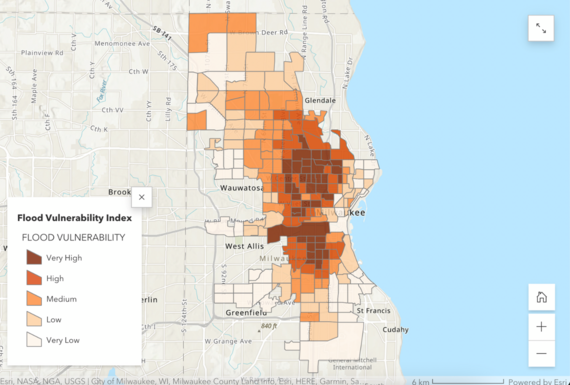 Flood vulnerability map of Milwaukee. Flood vulnerability was determined through a combination of housing, health and socio-economic vulnerability metrics.
The FHVA found that approximately 39% of Milwaukee’s population lives in a neighborhood that has high flood exposure, high flood vulnerability or both. And the study found that not all residents are equally susceptible to the physical and health risks of flooding. Compared to the rest of the city, Black residents are more likely to live in high-flood-exposure and high-flood-vulnerability Milwaukee neighborhoods due to economic factors, like poverty and unemployment, and difficulty accessing healthcare. Groundwork Milwaukee and its partners can use these results to prioritize flood management intervention efforts in neighborhoods that are most at risk.
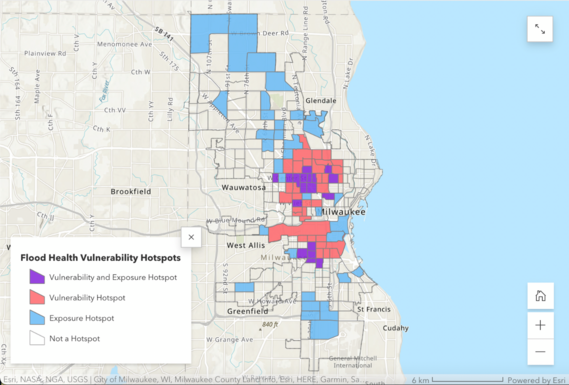 Map of flood health vulnerability hotspots in Milwaukee, WI. Purple areas are those with both high flood exposure and high flood vulnerability.
What Does It Mean To Live In A Flood Vulnerability Hotspot?
The Metcalfe Park neighborhood in Milwaukee is one of these priority areas, with a high exposure and high vulnerability to flooding.
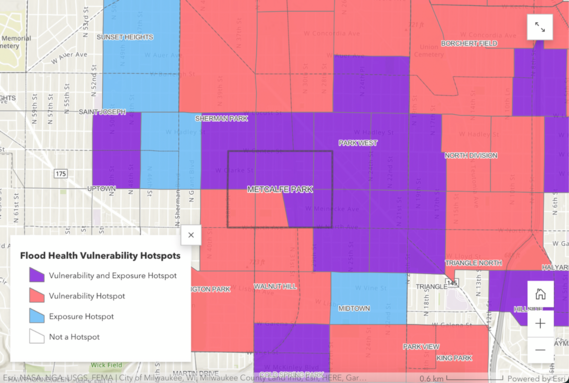 The Metcalfe Park neighborhood in Milwaukee is an area of high flood exposure and high flood vulnerability, as indicated by purple shading.
Inland pluvial flooding – flooding that occurs with high-volume precipitation events, like flash floods – is of particular concern in Metcalfe Park. The high density of brownfield sites and blighted land in the neighborhood increase the possibility of exposing residents to toxic pollutants, intensifying flood-related health concerns.
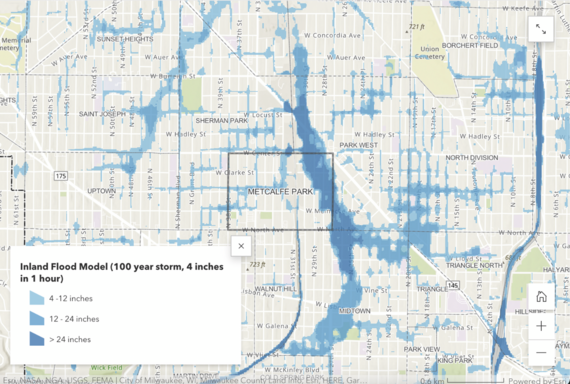 Inland flood exposure in Metcalfe Park.
Metcalfe Park is surrounded by an industrial zone and is divided by the 30th Street Corridor railway. Its proximity to this infrastructure has created lasting social, health and economic challenges in the neighborhood. Historic redlining policies in the 1930s determined that both the east and west halves of the neighborhood on either side of the railway were not suitable for mortgage loans, facilitating racial and economic segregation that remains to this day, with ~98% of Metcalfe Park residents identifying as BIPOC.
These policy decisions have affected the community’s ability to build wealth, access healthcare and acquire resources for climate adaptation. When Metcalfe Park floods, many residents struggle to pay to repair property damage, and as persistent flooding increases the likelihood of adverse health effects, the lack of healthcare access becomes even more challenging.
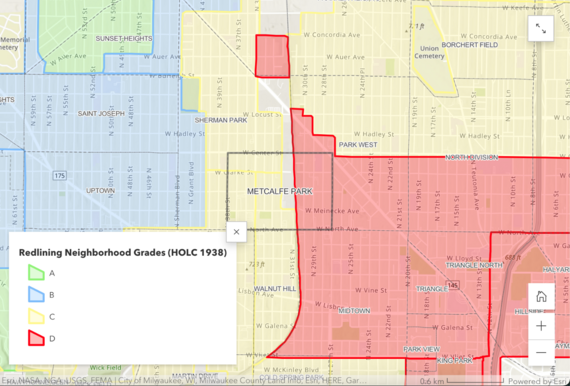 Redlining map of Metcalfe Park. The west side of the city was graded a C and the east side was graded a D. This historic segregation is present in the neighborhood today.
 Brownfield exposure map of Metcalfe Park.
Putting The Data To Use
Having data from the FHVA about Metcalfe Park’s acute vulnerability to flooding will allow residents and local groups to advocate for equitable investments in flood mitigation infrastructure for the neighborhood. Groundwork Milwaukee will be leveraging the results of the FHVA and the accompanying maps as a core part of their Climate Safe Neighborhoods partnership, in which they are using data about historic discriminatory housing policies to illuminate residents’ current climate experiences and engaging community members to organize to change the way climate adaptation resources are distributed.
By visually highlighting the overlap between flood exposure and vulnerability, the FHVA puts a powerful tool in the hands of the Metcalfe Park community to advocate for flood resilience and investments in flood mitigation infrastructure from policymakers.
To learn more about the Flood Health Vulnerability Assessment, visit Groundwork Milwaukee’s website.
The Dam Safety and Floodplain Program has had several personnel changes in the past year that we want to share.
Regional Water Management Engineers (WMEs)
We have had to say goodbye to our Regional Water Management Engineers, Mike Rogney, Mike Stone and Megan Duffy. We are fortunate they shared their talents with our program; we will miss them and wish them the best in their new endeavors. We are currently recruiting for their vacant positions.
Who Do You Call?
With the several vacancies, Water Management Engineer county coverage has evolved to balance work and access to water management engineers. Contact your County Water Management Engineer if you need assistance. Please keep the link handy since it will be updated again in several months.
Floodplain Mapping Program Coordinator
In November 2022, we also said farewell to our Floodplain Mapping Program Coordinator, Betsy Finlay. A big thank you to Betsy for her tenacity and commitment to producing quality floodplain mapping products.
Please help us welcome Emily Szajna as our new Floodplain Mapping Program Manager. Emily has been a valued Floodplain Mapping program team member for several years as GIS Project Lead. We are happy to have her stepping into her new role.
Emily will manage Wisconsin's floodplain mapping projects funded by FEMA Cooperating Technical Partner grants. A significant part of her role is grant administration and project tracking. She will also serve as the Floodplain Mapping Program GIS Technical Lead. Emily's work supports DNR floodplain mapping staff in delivering quality products to communities throughout the state. This ensures everyone is informed about flood risk in their community to keep people and property safe.
Emily is committed to working collaboratively with local communities and other state and federal agencies to continue this vital work.
Emily can be reached at Emily.Szajna@wisconsin.gov and 608-422-0365. Learn more about floodplain mapping on our website.
We're excited to have Emily Szajna join our DNR team.
The Shoreland Program Team has undergone some changes. Our Shoreland Policy Coordinator, Mike Wenholz, has left the DNR. The shoreland program now consists of Dale Rezabek, the DNR's Shoreland Specialist in the Oshkosh Office, with limited assistance coverage from Kathi Kramasz (Water Management Specialist in the NE Region) and Kay Lutze (NE Regional Supervisor). This will prompt a change in county coverage and requires the program to reprioritize core work for a limited time until we can fill the Shoreland Team lead position.
For the interim period, the shoreland team county coverage will be as follows:
Kay Lutze will be the point of contact for all municipalities within the Lower St. Croix Riverway under NR 118 and will provide technical assistance in shoreland zoning coverage under NR 115 for Pierce, St. Croix and Polk counties. Kathi Kramasz will be covering shoreland zoning for 16 counties in the SE Region and will be the point of contact for Buffalo, Pepin, Trempealeau, Eau Claire, Clark, Marathon, Dunn, Taylor and Chippewa counties. Dale Rezabek will continue covering the SE and NE regions and the 10 additional counties in the NW region.
Moving forward, when sending us required public notices for Board of Adjustment hearings, indicate in your email subject line that there is/are shoreland standards in the variance applications, and also add to request department comment/opinions if wanted by the zoning staff and the Board of Adjustment.
Example: “Subject: Oconto County BOA Hearing – SZ setback variance. Comments requested.”
We appreciate your patience!
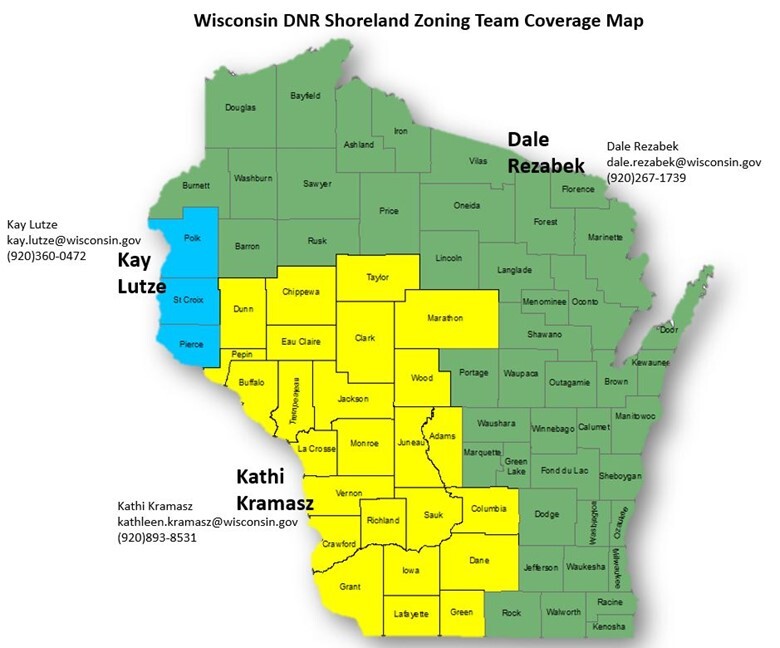
Floodplain 101
Please join Sarah Rafajko, DNR Floodplain Management Program Coordinator, for a virtual course on floodplain management. This will be a state-specific training covering information pertinent to zoning officials in Wisconsin. Topics will include an overview of floodplain regulations, updating a community’s floodplain ordinance, substantial damage/improvement (“the 50% rule”) and grant opportunities. All are welcome to attend, but the information will be geared toward those who work in floodplain zoning. An email with more details will be sent in the coming weeks.
Coastal Floodplain
We are happy to announce an upcoming joint DNR/FEMA-led opportunity aimed at communities that have been, will be or are currently going through the FEMA Letter of Final Determination process and are receiving maps with Coastal V zones. This would include all counties and municipalities along Lake Michigan and Lake Superior. This is planned to be an in-person training and is tentatively scheduled for January or February. You can expect to receive an email with more details as soon as they are finalized.
Talk with FEMA and DNR Floodplain Program representatives during monthly virtual Wisconsin Floodplain Management Office Hours. Hours are 10 – 11 a.m. on the third Thursday of the month. Bring your questions and scenarios for guidance and discussion. If you have a floodplain development issue, another community is likely facing a similar issue. Office hours allow many to engage and learn from each other's experience as we develop solutions to your unique scenario.
Join us on Microsoft Teams for the upcoming monthly hours on the specified date from 10 – 11 a.m.
RiskMap (Risk Mapping, Assessment, and Planning) is a FEMA-led process used to make flood insurance rate maps. However, this is only one thing created as part of this process. Various datasets, hazard mitigation analyses and communication tools are shared with affected communities. Each of these tools help support communities toward resiliency. Datasets related to flood risk products work alongside regulatory products to provide flood risk information and support the community's floodplain management and hazard mitigation strategies.
Letter of Final Determination and effective dates are essential milestones in a flood risk project. The Letter of Financial Determination is a letter sent to the community CEO stating there are new or updated flood insurance rate maps. The receipt of this letter starts the 6-month adoption compliance phase of the process, where communities need to update their floodplain ordinances by the map's effective date to remain in good standing in the National Flood Insurance Program (NFIP). The table below shows when the Letter of Financial Determination will be distributed and the 6-month window in which cities, villages and counties must complete the adoption process.
The DNR can help the community draft the ordinance to save on costs. Our assistance is provided to communities free of charge. If you are interested, please get in touch with DNR at DNRFloodplain@Wisconsin.gov.
|
County
|
Status
|
|
Racine
|
Started July 11, 2023, effective date Jan. 1, 2024
|
|
Taylor
|
Started Sept. 13, 2023, effective date March 13, 2024
|
|
Kenosha
|
Started Oct. 11, 2023, effective date April 11, 2024
|
|
Door
|
Started Nov. 8, 2023, effective date May 8, 2024
|
|
Ozaukee
|
Started Dec. 20, 2023, effective date June 20, 2024
|
|
Shawano
|
Starts Jan. 17, 2024, effective date July 17, 2024
|
|
Kewaunee
|
Starts Feb. 28, 2024, effective date Aug. 28, 2024
|
|
Sheboygan
|
Starts Feb. 28, 2024, effective date Aug. 28, 2024
|
|
Milwaukee
|
Starts April 24, 2024, effective date Oct. 24, 2024
|
*Please note that the dates listed above are tentative for communities that still need to go through a Letter of Financial Determination.
About The Wisconsin Floodplain Management Program
The program's goals are to protect life, health and property; to minimize costs for flood control projects; to reduce tax dollars spent for rescue, relief and repair of flood damage; to shorten business interruptions caused by flooding; to prevent future flood blight areas; to discourage victimization of unwary land and home buyers; and to prevent increased flood levels caused by unwise floodplain development.
Contact Us
Floodplain: Sarah Rafajko, Sarah.Rafajko@wisconsin.gov
Shoreland: Kay Lutze, Kay.Lutze@wisconsin.gov
Dam Safety: Uriah Monday, Uriah.Monday@wisconsin.gov
|